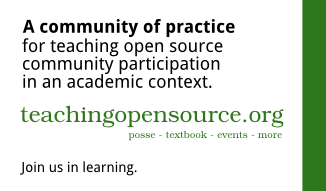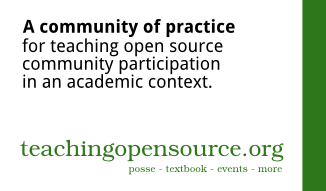Huh. Font licensing.
So this afternoon I was making business cards for Teaching Open Source community members to hand out at the big SIGCSE conference that's coming up.

As I went along, I uploaded images and chattered away in our public IRC channel, #teachingopensource (freenode), to open up the possibility of drop-by comments and contributions. (TOSW tip: enable other people to pleasantly surprise you, and sometimes they will.) And lo and behold, Karsten Wade came along - "I would be interested in seeing a version without the 'join us' at the bottom, and the URL-etc. pushed down a bit," said Karsten Wade. "I think it really makes the whole thing more readable to have that whitespace."
And it did.

We kept talking, and Karsten asked me to check out his blog post about a slip-up on font licensing for theopensourceway.org. Shoot, I thought. Didn't think about that. I'm about to tell people they can remix these cards for their own purposes... did I actually use open-licensed fonts for this design? I'd used Droid Sans for the sans-serif font and URW Bookman L for the serif; both were included in Fedora packages (and I hadn't installed any non-free fonts on my computer), but I wanted to make sure and find out what licenses they actually had.
Fortunately, Fedora design guru Mo Duffy keeps a table of font licenses on her website. A quick check, and... phew - I was good. Everything was redistributable. But the Bookman font said it was licensed under the "GPL with Font Exception." What the bloody blazes was a font exception? Looking around led me to an old blog post by David Turner, a former colleague of mine from Open Plans, who worked for the FSF before that and wrote about exactly these kinds of issues every day. Between that and a section of the official GPL FAQ, I kinda figured it out.
The normal GPL license says that if you use a GPL-licensed thing as part of something else you make, the entirety of that something-else has to be GPL-licensed as well. This is called copyleft, and it's a simple but powerful idea - basically, infectious freedom. So let's imagine I'm writing a document on my computer - being the FOSS geek I am, this means OpenOffice running on Fedora - and I'm using a GPL'd font, and embed that font into my document because I want to make sure it formats the same way when I send it to someone else, and... wait, hang on there. Does that mean I now have to license every single paper I write that way under the GPL, since I'm using a GPL-licensed font as part of it?
That's where the font exception clause comes in. Essentially, it says that if you're just including that font in a document in order to typeset it, copyleft does not apply; the document itself can be as proprietary as you like. Handy if you need to prepare documents that must legally be private (student grades, etc[0]) but still like open source apps and fonts. I thought this was pretty cool - a random little snip I hadn't expected to learn about, but came across today anyhow.
"I never even thought of that legal scenario," I told Karsten. "Don't worry," he said. "RMS has."
[0] Thanks to Jason Aubrey and Chris Tyler for getting me started thinking about FERPA again. It's a good reminder that there are legal/privacy issues that professors need to think about when designing courses - what if students don't want their work publicized, or if they don't want others to be able to see their professors' code review comments? Standard release forms might be a nice thing to include as part of the arsenal we're giving POSSE professors.